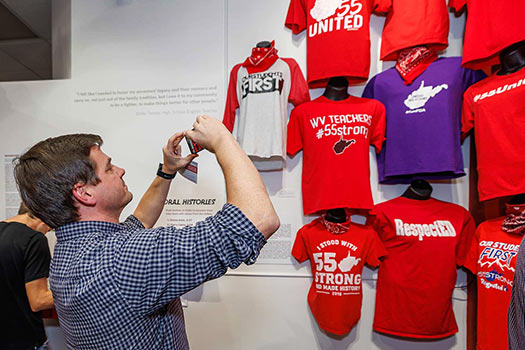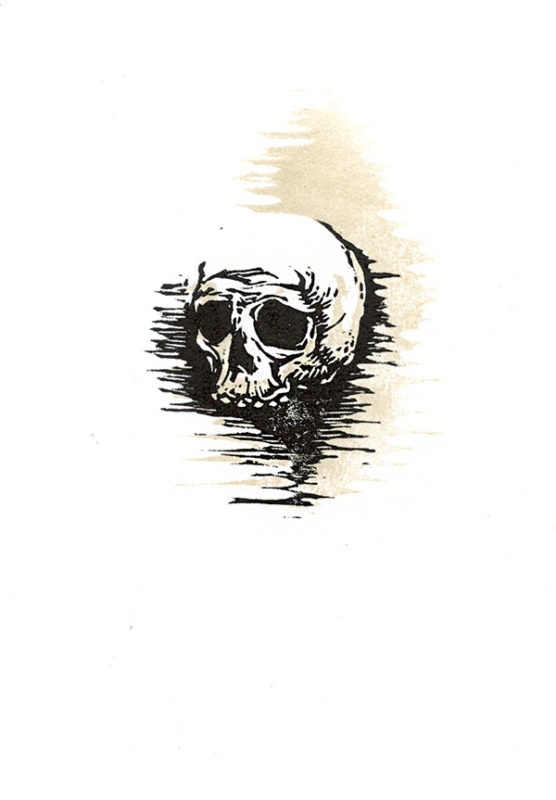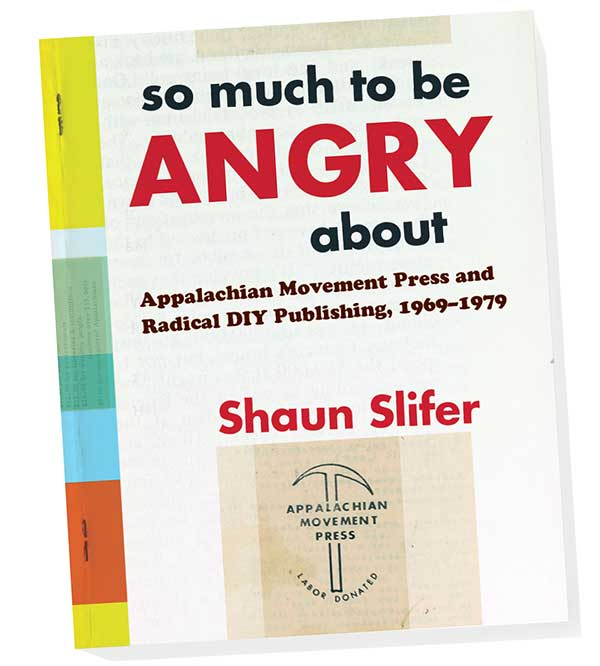
Last autumn, I finished up a design for a new poster in the Celebrate People’s History series, and it’s just now hot off the presses (you can get it here)! The subject of the poster is the Luddites – not those contemporary freaks without Instagram accounts, but rather the original insurrections in the Midlands of England, roughly 1811-1813, during the violent creep of mechanization of the trades into the cultural fabric of English society. I thought it would be worthwhile to detail my design process here.
The Celebrate People’s History series was my first entry into my now-entrenched involvement with Justseeds. I met Josh MacPhee at the Underground Publishing Conference in Bowling Green, Ohio in maybe 2002 (it’s now the annual Allied Media Conference in Detroit). At that time, Justseeds was JustJosh, and he was tabling the conference with all of these amazing educational “People’s History” posters like I’d never seen before. I was enthralled, and he gave me a large stack of them, which I took home to wheatpaste around my then-home city of Nashville. I hung them on the walls of the cafe I worked at, and generally showed them to anyone who would look. Not long after, I designed an early poster for the series about Elisee Reclus, the renowned geologist and anarchist. Years later, I collaborated with Sara Beth Meister on a poster about the Kalamazoo Corset Strike of 1912. By that time, Justseeds had become a cooperative endeavor, and my integration in the group was in full swing…
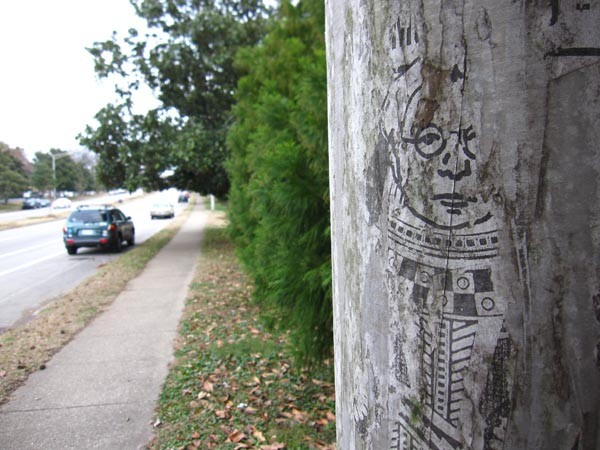
[Emma Goldman People’s History poster wheatpaste in Nashville, still up after over ten years!]
The posters in the Celebrate People’s History series never provide the full scope of the stories they tell. They are, instead, starting points for further searching and story-telling. That said, it’s hard for someone like me, who increasingly works with text-heavy imagery and struggles with telling history without talking “context”, to boil everything down to a simple educational graphic, a starting point.
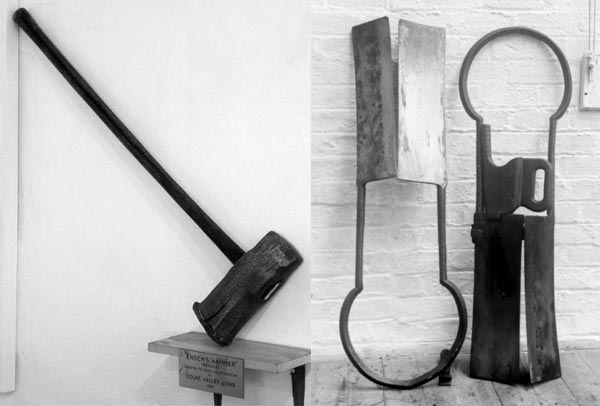
[“Enoch” sledgehammer b/w wool cropping shears]
I originally wanted to work with as little text as possible, challenging myself to find succinct imagery that would tell the story on it’s own. Sledgehammers are probably the most common tool associated with the Luddite rebellions – they were used to batter down the doors of the factories they sabotaged in the dark of night, and then the same hammers were often used to render the new steam-powered looms and stitching frames housed inside. But, what does it mean to constantly utilize imagery of weapons in memorializing revolutionary struggles? I think it’s mostly about reaching for the closest, simplest images that express power and counter-power, but I feel these notions can get oversimplified through overuse. And, it just gets weird: hammers were at the terminal end of this struggle, they weren’t the tools of the trades and lives at stake. The Luddites were textile craftspeople and their communities – they only took up weapons when their entire livelihoods were jeopardized, and only then after continual petitioning to redress their grievances through allowed political channels. When backed into a corner, they also picked up axes, pistols, pikes, and torches—whatever they could get their hands on.
All that is to say, I couldn’t settle on an object, or tool, to concentrate on. So, I went in the opposite direction: heavy on the text! Some of the original printed posters from the era still exist, which document Luddite activity and government response to it – they are the “Wanted” posters of the era, and they are beautiful if only for their letterforms.

I wanted to strike a careful balance between locating fonts similar to the era, and creating a sort of facsimile of their age through distress. These old flyers were letterpressed, because that was the way it was done, but I don’t have the resources to fully letterpress this new design. Irony aside, I picked up the mouse and keyboard. I used the site whatfontis.com to locate some free-use fonts which matched some of these original headlines. Something Erik Ruin said to me years ago, about distressed fonts being akin to acid-washed jeans, kept ringing in my head, and I didn’t want to go overboard looking for something “antique”. I reached back to an old design trick from my younger days: distressing images through multi-generational photocopying.
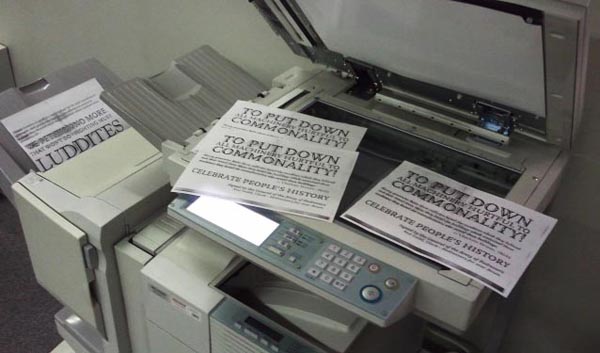
This is harder than it used to be, because photocopiers have a lot tighter output in the 21st century. But the basic idea still works (and works best on an older machine): you photocopy an image, and then you lay that new copy on the scan bed. Make a copy of that, then put this next copy on the scan bed. After a few “generations” of this, the image starts to accumulate noise and detritus, much more random and interesting than a pre-distressed font could ever be. You also have a lot of scrap paper lying around for future sketches or to write letters to friends on…

I scanned these copies back in for the headlines, but I still reached for an era-specific font for the smaller body text: Leander (by Tension Type) seemed to fit what I was looking for. I had tried to degrade that text in the same manner as the headlines, on a copy machine, but it just became illegible. I recommend Font Squirrel if you’re looking for new fonts to play with – they have a very well-selected database of fonts, many of them free, and they don’t go in for the whack un-useable headline fonts that so many other “Free Font” websites traffic in.
The text is a combination of original statements from various notes left by Luddites for the factory operators in the areas. I also pulled a description of the Luddite’s motivations from Charlotte Bronte’s Shirley – not a book about the Luddites exactly, but it takes place with the textile trade insurrections as the backdrop.

[Leander font]
I still wanted an image at the top to lead the poster. I found this nice engraving of the Cartwright Mill: a banner example of a newly-mechanized textile factory of the sort the Luddites set their sights on. It was actually attacked by Luddites, but the attempt largely failed at its end goal. I thought about this, and decided to take some license and illustrate the mill as though it had been successfully attacked, the end goal being to blaze the whole operation.
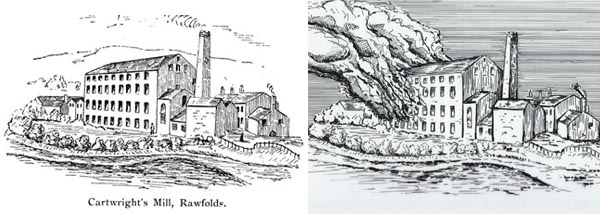
[original illustration b/w my version, including arson]
Fire isn’t easy to draw. But, with fire comes smoke, and quite a bit of it if you’ve just torched a multi-story building. I imagined the glow of the flames inside as merely a highlight to billows of black smoke expanding across the English countryside, blocking the moon and stars – a victory plume to some, a warning beacon to others.

Since the Luddites were operating in the dark of night, the conflaguration was only appropriate to illustrate under the stars. And, during 1811, there was an amazingly visible comet in the sky every night, globally. Remember seeing the Hale-Bopp comet in 1997? It was like that, but if you subtract a lot of 20th century astronomical knowledge, you might imagine that the view pretty well whigged a lot of people out. Peter Linebaugh writes about this in his pamphlet on the Luddites, using the comet itself to frame global points of insurrection beyond the English Midlands. I put the comet in there, a nod to the unknown and perhaps “cosmic” motivations behind such insurrectionary movements.
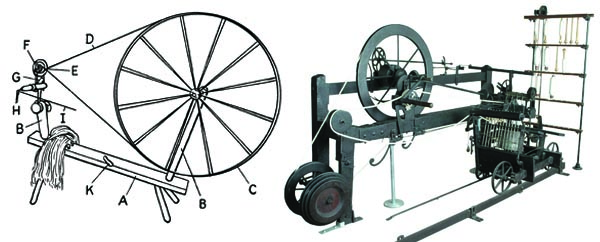
[spinning wheel b/w steam-powered mule jenny]
I also wanted to nod, somewhere on the poster, to the trades of the insurrectionists themselves. Textile manufacture isn’t just about the knitting, it’s the whole process from animal fur, to spinning, to sewing, etc. I thought about cropping shears – these massive wool-shearing tools which presumably-huge men wielded upon restrained sheep. They are kind of obtuse looking – but a spinning wheel is recognizable, and a spinning wheel wasn’t a gender-specific tool. You can still find these things too, for the modern fabric engineer who wants to work from the source. I found a suitably simple example and drew it out. It was satisfying to contrast this graceful tool with the burning industrial prison – yeah sure, sledgehammers would have been used to gain entry to the factory to torch the joint, but what was at the root of this battle? Craft, livelihood, a community of tradespeople and their families working in their homes which formed and was nurtured at the core of clothing production. The steam-powered factory was the antithesis of this community, a weapon against it, a harbinger of the new industrial production philosophy we can now easily take as the “natural” state of things.
I should say that I also hoped to create a poster which would begin to reclaim the original history of the word “Luddite”. In a sad twist of time (no doubt partially a result of skewed historical writings), the term is almost solely understood as a pejorative in the modern lexicon: “Luddites” can be anyone who isn’t primed for the next technological innovation, who may prefer an older methodology, or is simply cranky about the general quickening pace of modern industrialized societies. Do you prefer writing letters to email? You could be a Luddite. Don’t know what an Instagram is? Luddite. Find enjoyment in hand-boring holes in wood with a brace-and-crank instead of a Lithium-Ion cordless drill? Luddite. Feel like smacking the Google Glass off that dude’s face and grinding them righteously, passionately, under your trembling bootheel? That last one just indicates that you’re a reasonable, compassionate human being. But maybe you see where I’m going with this…
“Luddites” in 1811 were followers of Ned Ludd, or General Ludd, a potentially fictitious leader who “signed” many declarations on behalf of a growing people’s movement of shearers, croppers, stocking knitters, and other textile workers and their families in England. It wasn’t so much that Ludd was their leader, rather General Ludd was a rallying concept. The textile industry was one of the first industries to see steam power replace individual craftspeople and communal work environments. The Luddite insurrections are often represented as a reactionary backlash by simple peasants to their replacement by efficient machines, but I believe the situation is better understood as one of the first organized revolts against the age of industrial capitalism in Western Europe.
Since the late 1700s, the English working class watched their common farming homelands divided up and fenced in by new and wealthy landlords in a swift sea change historically labeled the Enclosure Movement (the clear precedent for contemporary private property laws). These people were fully cognizant of their situation when steam-powered technology soon after began to make it’s way into their lives through factories: another assault on the core of their lifestyle was underway, putting thousands more out of work and destroying the roots of their lifestyle and family bonds. Groups of armed men and women stormed factories in the dark of night, smashing down the doors and destroying the machines inside. These actions occurred in conjunction with food riots in open markets, led by the women in these communities. At the height of the insurrection, some Luddite groups went so far as to attempt the assassinations of factory owners.
The English government moved swiftly to provide state aid to wealthy independent business owners in order to quell the uprisings, setting a precedent for the synergistic state relationship with industry and capital observed today. The destruction of a “machine” was made a capital offense in 1812 – in other words, the English government was willing to execute anyone who went so far as to destroy a knitting machine. This wasn’t a simple binary of rational people inventing great new machines vs. irrational people who didn’t like those machines or want to change their ways. This was guerilla war for the preservation of a culture being sacked at its root by proto-capitalism.
Thanks for reading! You can get copies of the poster right here at Justseeds. Deftly offset printed by the wonderful folks at worker-owned/operated Stumptown Printers in Portland, Oregon.
Suggested reading:
Kirkpatrick Sale, Rebels Against the Future: The Luddites and Their War on the Industrial Revolution, Addison-Wesley Publishing Company, 1995
Peter Linebaugh, Ned Ludd and Queen Mab, Machine-Breaking, Romanticism, and the Several Commons of 1811-12, PM Press, 2013 (this is a pamphlet, but the essay can also be found in Linebaugh’s excellent, newly released collection Stop, Thief!: The Commons, Enclosures, and Resistance, also on PM Press)
Richard Holland also has scads of documents and research about the Luddites on his blog here.
